Dogwood Bushes for Sale Online
Dogwood shrubs are deciduous shrubs that are very useful for designing a landscape that provides four seasons of interest. These fast-growing shrubs add spectacular color to any planting when little else is attracting any attention. Native to Maryland, the Red Twig Dogwood makes a phenomenal and eco-beneficial addition to any planting project.
Unlike most deciduous shrubs that end their show once the leaves fall, dogwood shrubs genuinely stand out in the garden after leaf drop. As one of the most popular winter interest plants, Dogwood shrubs will remind you that there are four seasons in the landscape every winter when their true virtues light up the yard and transform it!
Benefits of Dogwood Shrubs
Four Seasons of Interest
The number one reason to plant a dogwood shrub is the benefit of four seasons of beauty! Beginning in spring, Dogwood shrubs offer a beautiful show of green foliage and small blooms.
As the shrub makes its way into the summer season, you will begin to enjoy the summer berries that the sweet shrub produces! In fall, these deciduous shrubs put on a stupendous show of color with deep reds that melt into vivacious oranges and yellows.
The real show of the dogwood show though, debuts in winter! Once the shrub has shed its foliage, you are greeted with the delightful surprise of the most colorful branches and bark! Depending on the cultivar you choose, you could have anything from passionate blood red to a sunshine golden yellow! Dogwoods are extremely popular winter-interest shrubs for this reason.
Hardy To The Elements
The next reason you might select a dogwood shrub to incorporate into your landscape is for the ease of care and extreme hardiness of the elements that this shrub withstands. These shrubs will thrive in just about any soil type and they can handle intense winter conditions along with humid summer rays.
Food Source For Local Wildlife
The last benefit of planting dogwood shrubs would be for the benefit of your local ecosystem. Berry-eating birds especially enjoy these shrubs and use them as a source of sustenance.
In a scholarly research study done for the Animal Nutrition Journal, scholars dive into the many benefits offered by red twig dogwoods to local wildlife!
Buying The Right Dogwood Shrub
What Is Your Grow Zone?
The first step to designating which Dogwood Shrub is right for you is determining your climate and growing conditions. The most full-proof way to do this is by calculating your USDA Grow Zone. We've gone ahead and simplified this process for you with our convenient and easy-to-use Find Your Grow Zone Tool!
To determine which Dogwood shrubs will grow well in your specific grow zone, simply type your zip code into the Find Your Grow Zone Tool and let us do the rest!
What’s Your Landscape Style?
There is an extensive array of different types of Dogwood Shrubs. All types typically do well in full sun to part shade in various soil conditions. And choosing the best type of Dogwood comes down to the location and size of the garden, along with your personal style and landscape vision.
Extreme northern gardeners will find the Red Osier types or Cornus sericea reliably hardy as far north as Zone 2. This is by far the hardiest of the dogwood bushes. All other types will be reliably hardy in gardens as far north as zone 3 in the United States.
The red osier type is also useful in the deep south, where heat and humidity affect dogwood bushes. Cornus sericea is unaffected by the heat as far south as zone 9, while the other varieties thrive only as far south as 7 or 8.
The most vivid stem colors come from the new growth, so pruning is often a way to enhance the winter interest of these colorful plants. As the shrubs age, rejuvenation pruning can be done. Regenerative pruning is simply the act of removing one-third of the items in the fall. Pruning can also help reduce the plant's overall height, allowing it to fit into smaller landscapes.
A by-product of this procedure is that pruning the stems in the fall allows you to incorporate the cut branches into colorful holiday arrangements and entryway pots.
Types of Dogwood Shrubs
Red-twig dogwoods:
The deep red stems make this a more popular choice by gardeners in the U.S., generally due to the explosion of red color that takes over in the winter. There are many selections of this native shrub ranging in height from 3.5 feet to 8 feet. Recent advances in breeding have made sections to fit any sized landscape.
This group is typically referred to as the Red Osier Dogwood or Cornus sericea and is native to the United States. The early spring white flowers are fragrant and produce white berries. This group is tolerant of wet areas and makes a stunning addition to a rain garden in full sun to partially shaded locations. The species red twig dogwood Cornus bailey is a standout member of this family.
Yellow Twig Dogwoods:
This smaller group of plants are cultivars of the Cornus Sericea family of Dogwood shrubs. Unlike its cousin which produces bright, red winter stems, this group has yellow stems.
The leaves and berries are similar to the red-stemmed Dogwood. While not quite as showy as their cousins, these shrubs are excellent choices for naturalizing and providing habitat and food sources for local birds and wildlife. The Yellow Twig Dogwood is easily one of our favorite options of Deciduous shrubs that add to the winter landscape.
Bloodtwig Dogwoods:
This relatively new group of plants has begun to find its way into the American Landscape. Native to Europe, the stems of this plant start yellow at the bottom and gradually change to orange or red towards the tip resembling flames. The fragrant white flowers turn to dark purple berries that are attractive to birds.
Blood twigs or Cornus sanguinea are more drought tolerant than their American cousins and are excellent choices for hillside plantings in full sun or part shade. This group stays shorter, only reaching heights of 3 to 5 feet.
Tartarian Dogwood:
Also known botanically Cornus Alba, these plants are native to eastern or central Asia and produce white flowers in the spring, which turn to white berries in the fall.
While not as flamboyant as the red-twig dogwoods of North America, these shrubs have interesting leaf shapes, textures, and colors. Cornus Ivory Halo produces large green leaves edged in white and grows to 5 feet tall.
Cornus stolonifera:
This species is closely related to the Cornus sericea family and is generally considered by many to be the same species. One standout member of this group is the Pucker Up Dogwood. Known for its attractive "Puckered" foliage and compact growth habit, this also stands out due to its resistance to leaf spots. Typically reaching only 3 to 4 feet tall, it's a good choice for smaller gardens.
How to Care for Dogwood Shrubs
Water
Unlike many shrubs, Dogwoods do well in boggy moist conditions! We suggest watering your dogwood shrubs regularly during their first growing season.
Soil
Your dogwood shrub will thrive in acidic, moist, well-draining soil.
Light
Dogwoods are not picky when it comes to lighting and they can handle conditions of both full sun to partial shade. For best results, plant your dogwood bushes in an area that gets at least four to five hours of sunlight a day.
Fertilizer
Dogwood shrubs do not require fertilizer, but they would benefit from the application of a well-balanced fertilizer blend like Bio Tone in the growing seasons of spring and summer.
Shop Dogwood Shrubs Online Today!
Here at GGD, we pride ourselves on offering a wide range of Dogwood Shrubs available for purchase online. Beyond that, we want to make your landscaping experience as seamless and convenient as possible!
By ordering your shrubs online, you can skip the hassle of crowds and plant transportation, for we ship directly to your front door!





